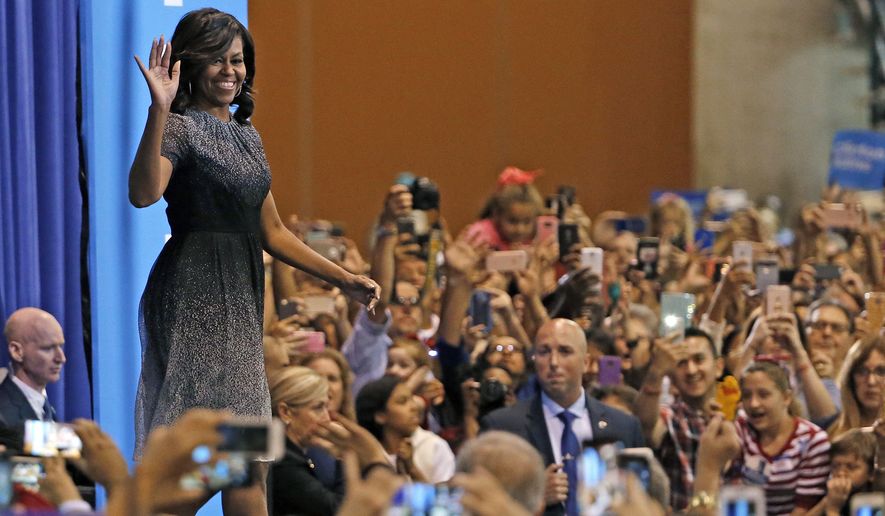For all but one of the past 15 presidential elections dating back to 1952, it would have been an act of political malpractice to send a Democratic first lady to Arizona in late October to campaign for a Democratic presidential candidate.
The state has voted Republican in every presidential election except 1996, when incumbent President Bill Clinton won. But Michelle Obama traveled to Phoenix last week, exhorting voters to support Hillary Clinton — an example of the changing makeup of battleground states and evolving voter demographics that ceaselessly favor Democrats.
When Ronald Reagan was president, it was still possible for a candidate to win nearly all 50 states. Reagan won 44 states in 1980, and he carried 49 states in 1984, losing only in Democrat Walter Mondale’s home state of Minnesota.
Since the Reagan era, however, presidential campaigns increasingly have focused on a dozen or so “swing” states where there is true competition for electoral votes — places such as Florida, Ohio and perhaps 10 other states that fluctuate from cycle to cycle. Growing minority populations, and white voters’ dwindling share of the overall electorate, have contributed to candidates devoting most of their time and resources to those swing states.
Glen Bolger, a Republican pollster at Public Opinion Strategies, said the demographic shift in the voting-age population “has changed at lightning speed.”
“When Reagan was first elected, the percentage of the electorate that was white was around 87 percent,” Mr. Bolger said. “This year, it’s going to be around 70 percent.”
The shifting voter demographics, coupled with Republican Donald Trump’s particular challenges with white women voters this year, are causing Democrats to compete in states where they didn’t stand a chance eight years ago.
In Arizona Mrs. Clinton is leading Mr. Trump in an average of polls, 42.2 percent to 40.7 percent. Mrs. Obama noted last week that President Obama lost the state in 2012 by slightly more than 200,000 votes — a difference of 63 voters per precinct.
“This year, we know it’s much closer here in this state,” Mrs. Obama said.
Georgia too appears to be in play. An Atlanta Journal-Constitution poll released Friday showed Mr. Trump with a 44 percent-to-42 percent lead over Mrs. Clinton. Georgia has not supported a Democrat in a presidential race since 1992, when Mr. Clinton carried the state.
Even Texas, which hasn’t voted for a Democrat since 1976, is considered hopeful territory for Democrats this year. A University of Houston poll had Mr. Trump leading by only 3 percentage points.
“Texas, which is getting 200,000 new Hispanic voters registered every cycle, is definitely trending toward Democrats,” said Democratic pollster Steve McMahon of Purple Strategies. “Democrats think Texas is 20 years away from being reliably Democratic, but Trump may have accelerated that. As the state gets less white and more brown, then the Republican Party becomes more antithetical to Hispanic voters. It’s pretty hard to imagine that it could go the other way.”
States can turn from red to battleground to blue relatively quickly. Virginia, which hadn’t voted for a Democrat since 1964, was considered a swing state in the past two presidential elections won by Barack Obama, and analysts now see it moving solidly into the Democrats’ camp.
Mr. Trump is running TV ads there but is campaigning in the state infrequently, including a stop on Saturday in Virginia Beach.
“Virginia is definitely purple, and it may be blue this year,” Mr. McMahon said. “That may be because of Tim Kaine [the Virginia senator who is Mrs. Clinton’s running mate]. But there are others states, such as North Carolina. It used to be that Democrats didn’t have a prayer in North Carolina. They’re getting younger, more diverse and, in particular, more Hispanic. And the Republicans are de-positioned among Hispanic voters — that’s the most generous way to say it.”
The growing Latino population’s alignment with Democrats, and the dwindling share of white voters, is one of the biggest challenges facing the Republican Party. Mr. Bolger portrays it as close to an existential challenge.
“It’s marginalizing us,” he said. “Mitt Romney did better with white voters in 2012 than George W. Bush did in 2000. And yet Bush won, and Romney lost. The math is changing. We’ve got to either keep up with it, or we’re going to consign ourselves to not winning presidential elections.”
Perhaps nowhere is the shift more clear than in Arizona. In the 2006 midterm election, Latino voters represented 9 percent of all votes cast. In the 2010 and 2014 midterm elections, Latinos accounted for 12 percent of all votes cast statewide. And in the 2012 presidential election, Latinos were a record 17 percent of all voters in Arizona.
In 2014, with the most recent Census data, the Pew Research Center said Arizona’s Hispanic population was 31 percent of all state residents, with 992,000 eligible to vote — about 22 percent of all eligible voters statewide.
Mr. Bolger said the trends are exacerbated this year in states such as Arizona and Georgia because of Mr. Trump’s unique candidacy.
“Democrats have talked about getting there in those two states for quite some time, but they really hadn’t gotten closer except now with Trump and the challenges he brings,” he said. “That’s why those two states are suddenly in play. If it was another Republican candidate, they would not be in play.”
• Dave Boyer can be reached at dboyer@washingtontimes.com.




Please read our comment policy before commenting.